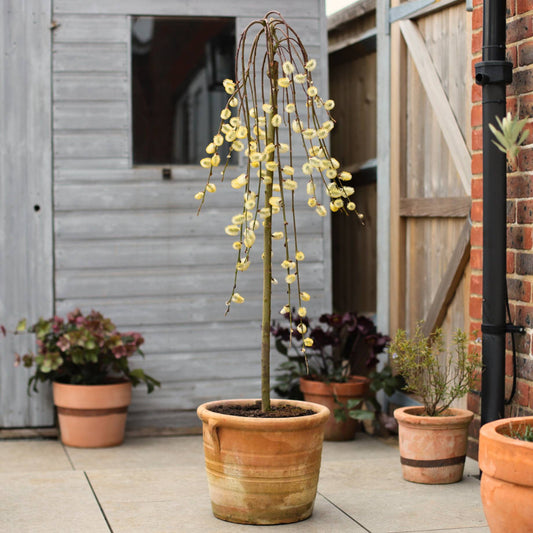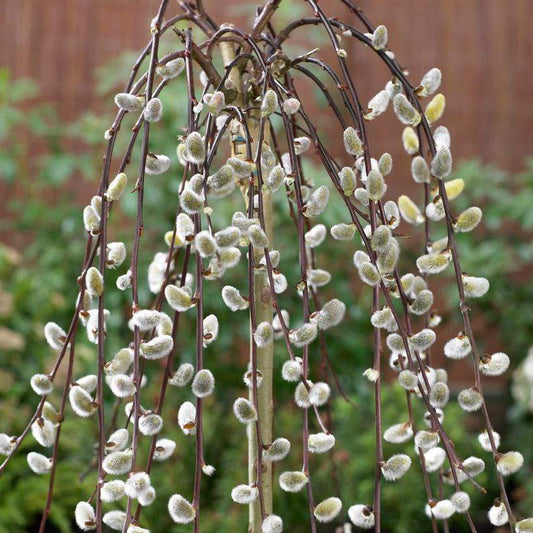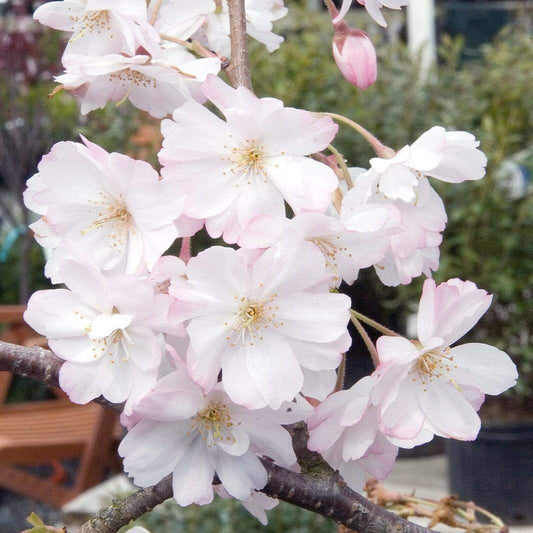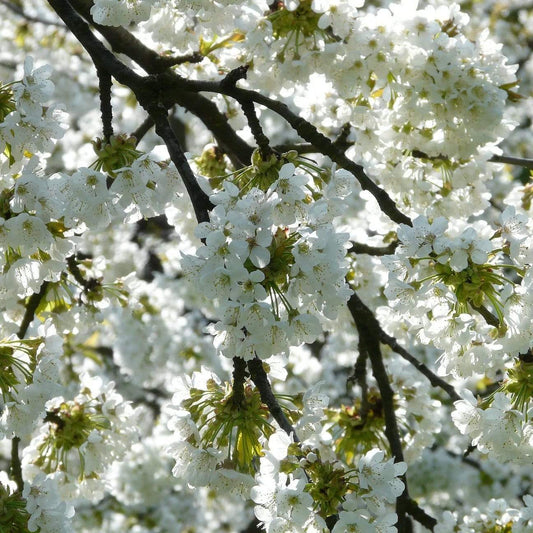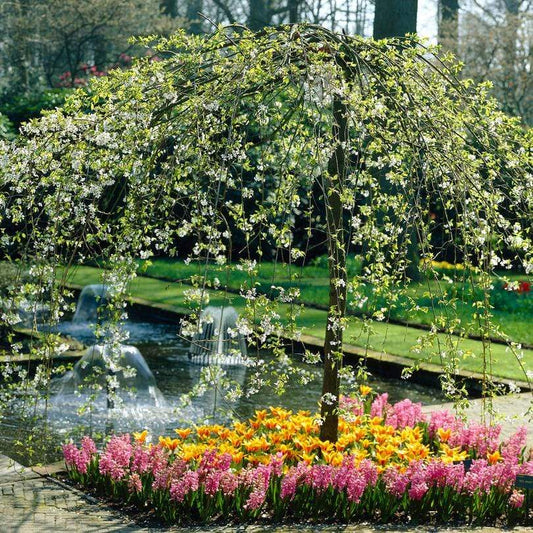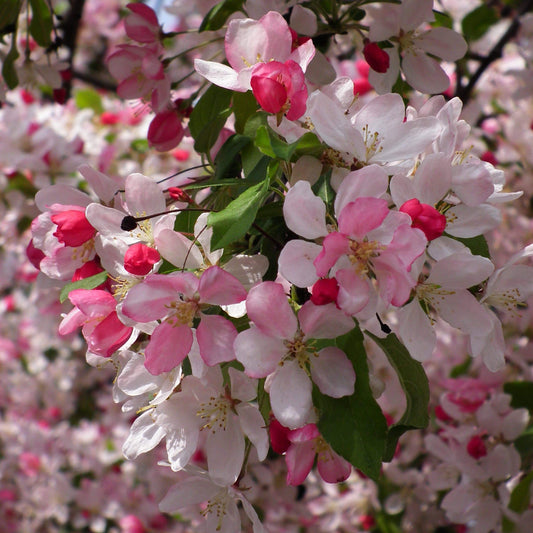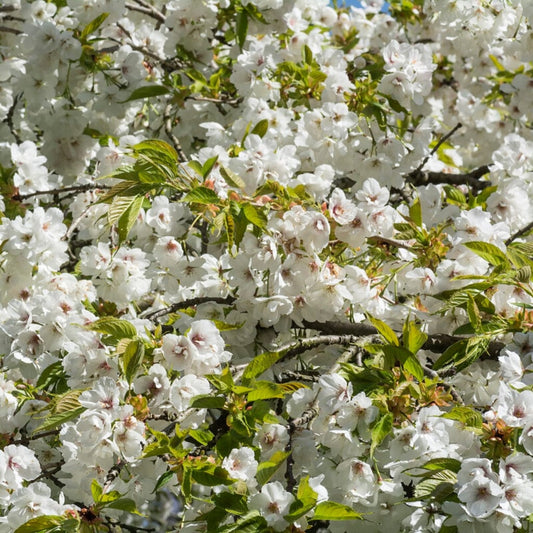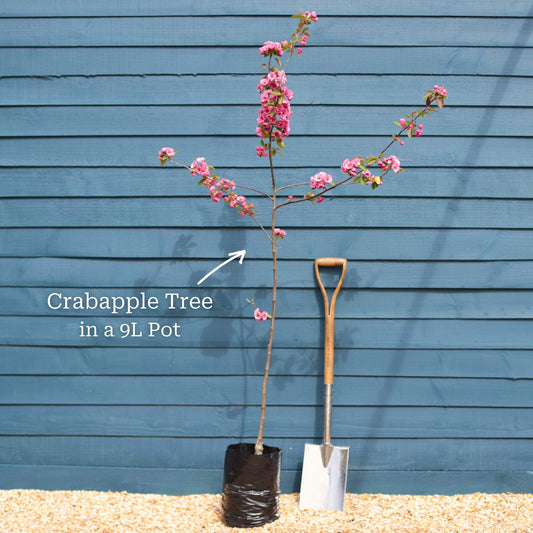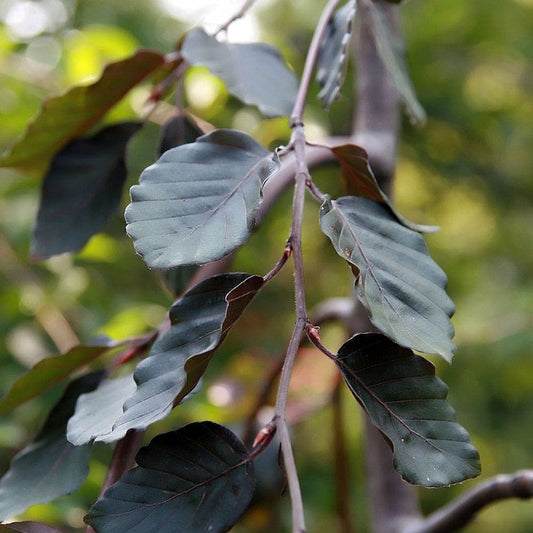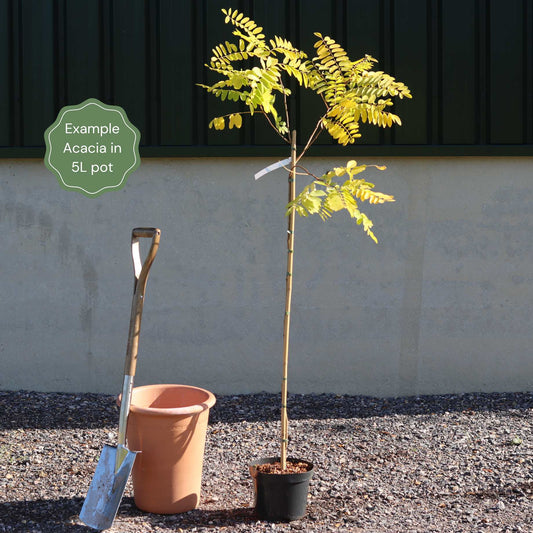Collection: Weeping Trees
Weeping trees are beautiful, easy to maintain and often very compact. From large statement Willows for landscaping or shade to dwarf Cherry Blossoms for kerb appeal in a small front garden, these ornamental, fruiting and flowering trees will turn heads all year round. Read about our favourite types and how to care for them here.
Need help picking?-
Regular price From £34Regular price
£38Sale price From £34Cheal's Weeping Cherry Blossom Tree | Prunus 'Kiku-shidare-zakura'
The little tree that packs a pink, fluffy punch
- Small, perfectly formed weeping cherry
- Can grow to 3.2m (depending on form)
- Rose pink, fluffy double flowers
- Clusters of blossom from April to May
3 options available
-
Regular price From £40Regular price Sale price From £40
'Kilmarnock' Dwarf Weeping Willow Tree | Salix caprea
A weeping tree… On your patio?!
- Proudly weeping tree
- Small tree - grows up to 2m
- Fuzzy grey-yellow catkins, deciduous foliage
- Can easily be grown on a patio
3 options available
-
Regular price From £30Regular price Sale price From £30
Golden Weeping Willow Tree | Salix 'Chrysocoma'
The iconic weeping tree!
- Elegantly weeping tree
- Large tree - grows up to 12m
- Chartreuse leaves becoming glossy green
- RHS Plants for Pollinators
3 options available
-
Regular price From £36Regular price
£38Sale price From £36Patio Cherry Blossom Tree | Prunus 'Kiku-shidare-zakura'
Cherry blossoms on the patio?!
- Patio tree with pendulous, weeping branches
- Small tree - grows up to 1.5m
- Bronze to green foliage, double pink blossoms
- Low-maintenance and fully hardy
2 options available
-
Regular price From £36Regular price
£38Sale price From £36Single Pink Weeping Cherry Blossom Tree | Prunus pendula 'Pendula Rubra'
Candyfloss flower statement
- Elegant weeping tree
- Can grow to 2.2m (depending on form)
- Rose pink single flowers
- Blossoms in March-April
2 options available
-
Regular price From £36Regular price
£38Sale price From £36Dwarf White Weeping Cherry Blossom Tree | Prunus 'Snow Showers'
Perfect spring time feature tree
- Elegant weeping tree
- Can grow to 1.7m (depending on form)
- Flurries of snowy white single flowers
- Blossoms in March-April
3 options available
-
Regular price From £36Regular price
£38Sale price From £36Dwarf Weeping Yoshino Cherry | Prunus yedoensis 'Ivensii'
Snow-white blossom overload!
- Beautifully weeping tree
- Can grow to 2.2m (depending on form)
- Green leaves (yellow later) and snowy blooms
- RHS Plants for Pollinators
2 options available
-
Regular price From £38Regular price Sale price From £38
Corkscrew Willow Tree | Salix matsudana 'Tortuosa'
Uniquely-shaped twisting stems
- Beautiful upright tree
- Large tree - grows up to 15m
- Lush green foliage, contorted branches
- RHS Plants for Pollinators
2 options available
-
Regular price From £36Regular price
£54Sale price From £36Weeping Yoshino Cherry Blossom Tree | Prunus yedoensis
Sweet almond scented blooms
- Elegant weeping tree
- Can grow to 1.7m (depending on form)
- Fragrant, sweet almond scented blooms
- Blossoms in March-April
1 option available
-
Regular price From £30Regular price
£37Sale price From £30'Sun Rival' Crabapple Tree
The perfect specimen tree
- A beautifully weeping, small tree
- Medium tree - grows up to 5m
- White blooms emerge from carmine pink buds
- Award of Garden Merit winner
1 option available
-
Regular price £60Regular price
£70Sale price £60Weeping Purple Beech Tree | Fagus sylvatica 'Purpurea Pendula'
Don't cry for me purpurea...
- Gracefully weeping tree
- Small tree - grows up to 3m
- Lush purple foliage turning copper in autumn
- Grows well in a wide range of conditions
1 option available
-
Regular price From £60Regular price
£65Sale price From £60White Weeping Cherry Blossom Tree | Prunus yedoensis 'Shidare Yoshino'
Loved by pollinators
- Elegant weeping tree
- Can grow to 2.2m (depending on form)
- Bowl shaped pale pink flowers
- Blossoms in April
1 option available
-
Regular price £28Regular price
£50Sale price £28'Crimson Cascade' Purple Crabapple Tree
A spectrum of pinks and purples
- Wonderful weeping tree
- Medium tree - grows up to 5m
- Purple to bronze leaves, magenta blooms
- Perfect for a front lawn feature tree
1 option available
-
Regular price £55Regular price Sale price £55
Purple Beech Tree | Fagus sylvatica 'Purple Fountain'
Brilliant burgundy foliage
- Upright, weeping tree
- Medium tree - grows up to 10m
- Alluring purple leaves turn copper in autumn
- RHS Award of Garden Merit winner
1 option available
-
Regular price £35Regular price
£50Sale price £35Patio Acer Tree | Acer palmatum 'Inaba-shidare'
Punchy purple patio hues
- Upright, semi-weeping patio tree
- Small tree - grows up to 1.5m (when pruned)
- Alluring burgundy, deciduous foliage
- RHS Award of Garden Merit winner
Currently out of stock
-
Regular price From £36Regular price
£55Sale price From £36Pink Weeping Flowering Cherry Tree | Prunus subhirtella 'Pendula Rosea'
Bronze toned fresh foliage
- Elegant weeping tree
- Can grow to 2.2m (depending on form)
- Semi-double, rose pink flowers
- Blossoms in March
Currently out of stock
-
Regular price £80Regular price
£109Sale price £80Best Trees for Small Gardens
Small in stature, big on impact!
- Statement weeping and bushy forms
- Three compact trees growing up to 2.5m
- Superb blossoms, catkins and rainbow foliage
- Easy to grow and great for pollinators
Currently out of stock
-
Regular price From £38Regular price
£55Sale price From £38Ornamental Weeping Silver Pear Tree | Pyrus salicifolia 'Pendula'
Lovely weeping ornamental pear
- Elegantly weeping tree
- Medium tree - grows up to 8m
- Grey-green leaves and snow-white flowers
- Ideal for smaller gardens
Currently out of stock
-
Regular price £65Regular price
£70Sale price £65Weeping Blue Cedar Tree | Cedrus atlantica 'Glauca Pendula'
Feathery blue, evergreen foliage
- Gracefully weeping tree
- Medium tree - grows up to 8m
- Needle-like, dark cyan leaves
- Award of Garden Merit winner
Currently out of stock
-
Regular price £165Regular price Sale price £165
Green Weeping Japanese Maple Tree | Acer palmatum 'Dissectum Viride'
Glorious emerald foliage
- Gracefully spreading tree
- Small tree - grows to 2.5m
- Fern-green, finely-dissected leaves
- Incredibly easy to grow and care for
Currently out of stock
-
Regular price £80Regular price Sale price £80
False Acacia Tree | Robinia pseudoacacia 'Rozynskiana'
Wonderfully weeping foliage
- Broadly oval to weeping tree
- Large tree - grows to 12m+
- Green, hanging leaves, scented, white flowers
- Incredibly long leaves (up to 50cm long)
Currently out of stock
-
Regular price £75Regular price Sale price £75
'Ruby Falls' Weeping Redbud Tree | Cercis canadensis
A compact, weeping redbud
- Compact weeping tree
- Small tree - grows up to 2m
- Deep ruby-red foliage, purple spring blooms
- Suitable for growing in containers
Currently out of stock
South Downs National Park
Meet Danielle
110 years' expertise free with every tree
Danielle's nursery has been growing trees in the South Downs National Park for over a century, and it shows. Dug up and sent straight to your garden at between 18-36 months old, their quality rootstocks, expert pruning and natural pest control mean that these traditionally field-grown trees are the hardiest you can get.
Need help picking?

Choose your Weeping Trees
Weeping trees are prized for their compact habit, and if your garden is smaller a Kilmarnock Dwarf Willow or Yoshino Cherry is perfect. If you have lots of space, it has to be a classic and elegant Golden Willow. For autumn colour we’d recommend the Weeping Silver Birch, and for year round interest, the wildlife-friendlySun Rival Crabapple or RHS Award winning Silver Pear. For a weeping Cherry Blossom, choose from Kiku Shidare, Single Pink or the larger Yoshino.

Where to grow your Weeping Trees
These weeping ornamental trees are typically very tolerant of any soil type, with Willows thriving in damp conditions. Weeping Pears will be fine in an exposed site, whereas Silver Birch prefers full sun and shelter. Weeping Cherry Blossoms do best with good air circulation around the canopy, and all weeping trees are best with minimal or no underplanting, owing to their cascading habit. For a position with lower light, the best choice would be a shade-tolerant Crabapple.

Weeping Trees Care Tips
All ornamental weeping trees will do well in any moist, well-drained soil. New trees should be watered in well and kept from drying out until their roots are well established (in a few months). They will benefit from a mulch in Autumn, and will typically need only minimal pruning to keep their shape. For more advice on growing weeping trees, see our Full Care Guides for each variety.
Happy plants make happy customers

Plants arrived in great condition and very promptly. Well established - much better than the ones I got at my local garden centre.
Monica Spence
| 24 May
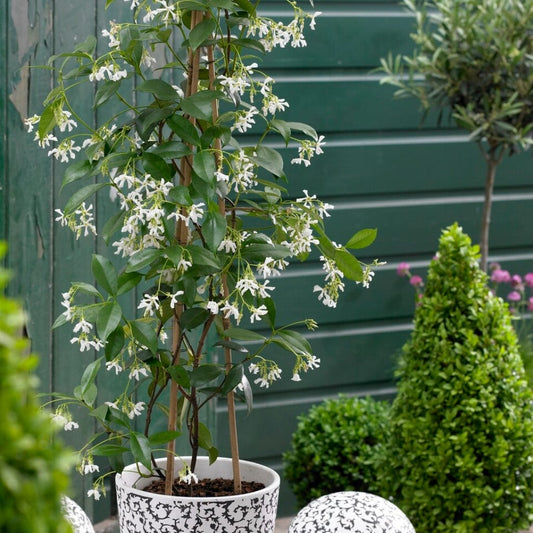
Yet again this company delivered good healthy plants, exactly as shown in photos, well packaged and within delivery time quoted. Recommend!
Jacqueline Burgess
| 2 Jun

I continue to be so impressed with Roots. Their customer care, knowledge of their subject: from planting hedges to pruning roses and more, has been a great support.
Judy Lane
| 23 Oct

The plant arrived looking vigorously healthy, which brings a smile to your face, extremely well protected in its packaging.
Martyn Hill
| 5 Jul

As a non-gardener, I found my whole experience brilliant. Great information & advice available on the website, great range of products & prices are brilliant.
John-Paul
| 22 May

Wonderful plants and great customer service... really surprised to find that the plants are better than those you would get at your local garden centre.
Gavin Wilcock
| 8 Nov
Fighting plastic waste
Delivering fresh from the nursery
Supporting UK growers



